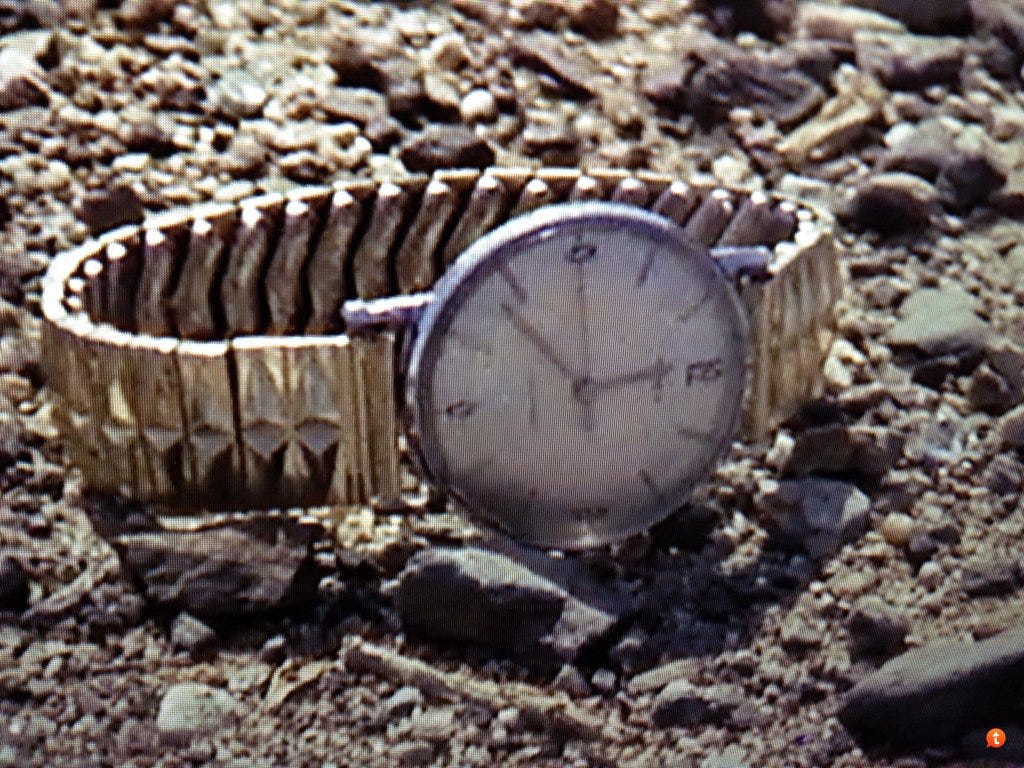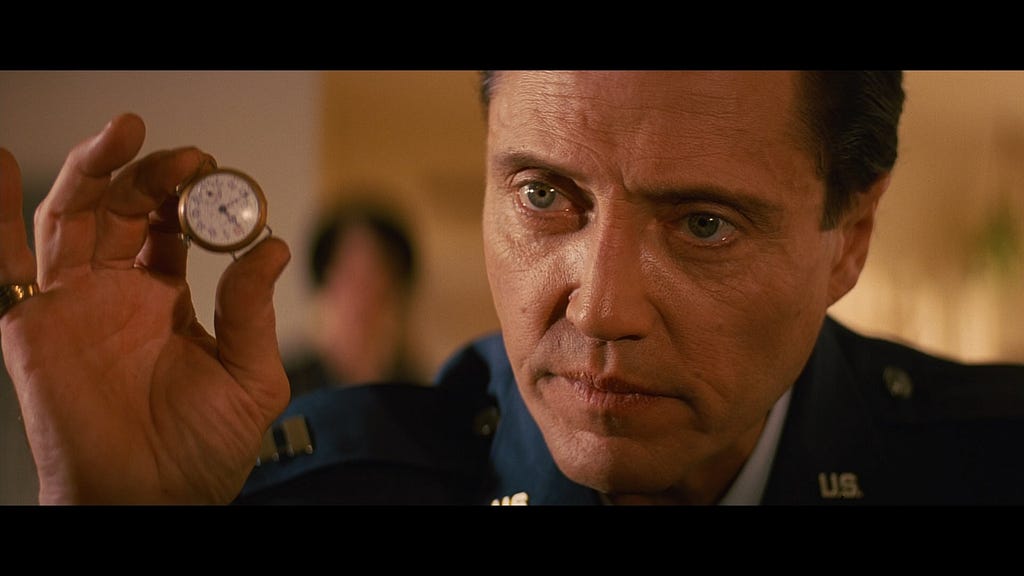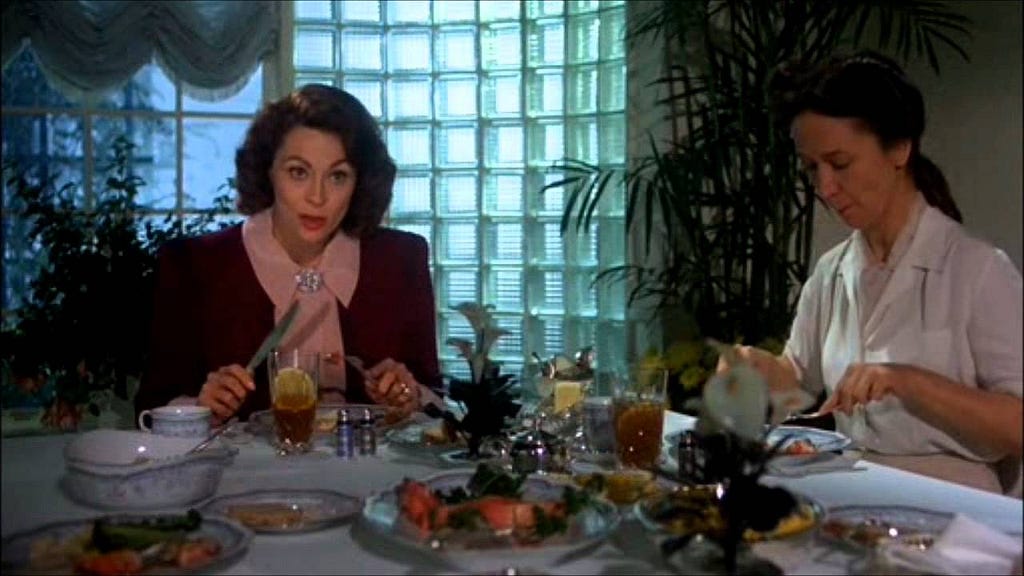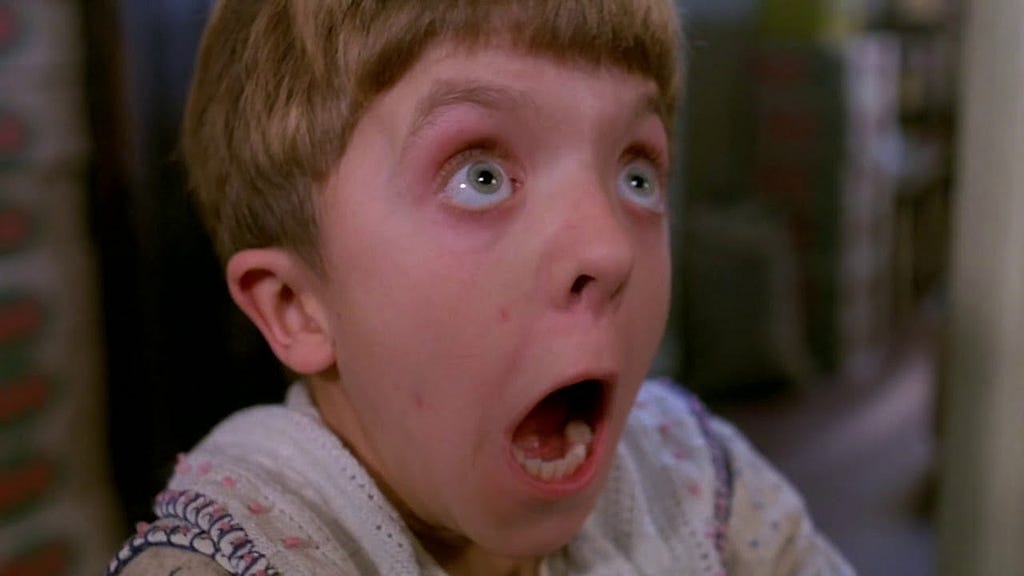Christian Marclay’s The Clock (2010) is an ambitious 24-hour montage stitched together from feature films and TV shows. Each clip, ranging from a split second to a few minutes, takes place during the time of the day at which it is played. Over the next few months, I will be attempting to see all twenty-four hours at the Tate Modern in London, documenting the experience in a way as haphazard as the fractured experience of watching the work itself.
Watching the Clock
The Clock does not ask for the time and then steal your watch; it asks for you to watch then steals your time.
Part 2 of this series. This article was written after viewing 11:21–13:06 (1 hour 45 min) and 14:30–15:25 (55 min) on 24 October 2018, for a total of 2 hours 40 minutes. Seen: 4 hours 15 minutes. Remaining: 19 hours 45 minutes.
Read Part 1: Introduction, in which I talk about my initial excitement about the return of The Clock.
Since my last instalment, I read an excellent New Yorker piece from 2012 which my friend had recommended, and to which I’ll refer throughout. I was excited to learn that Marclay had frequented the late Kim’s Video in New York, whose voluminous collection I visited in the distant past, and about which another excellent article was written (removed from The Village Voice’s website but fortuitously preserved by the Internet Archive).
Not only that but Marclay advertised for volunteers to watch the tens of thousands of hours he required at another DVD rental place, Today Is Boring, which once was on Kingsland Road in London, and run by a few friends of mine at the time—now also sadly defunct. Both of these facts excited me.
I arrived this time at the fairly early hour of 11:21am. I watched almost 3 hours on this day, which was much more than the 35 minutes that I watched in my first post. I sat down to Adrien Brody doing… something? In this case I didn’t write it down, I only wrote his name, so I must not have known the film. A minute later I recognised a church organ and Nordic singing, which I suspected was a scene from Bergman. Later on The Clock confirmed this by returning to the church: it’s from Winter Light (1963), a film that had a powerful effect on me the one and only time that I saw it.
Familiarity
This brings me to another aspect of The Clock, which is its unshakeable feeling of familiarity. Could you identify a film you loved from just a few seconds? Probably only if the scene were iconic, or if the film were an absolute favourite that you’d seen a dozen times. And yet equally, images you’ve never seen before can appear familiar, as a facet of cultural memory. In this sitting, for example, I recognised Laurel and Hardy, or Cheech and Chong, though I’ve never actually watched any of their films. It can be jarring to feel the certainty of having seen a scene which one cannot place, followed by a film that one has certainly not seen despite knowing exactly what it is.
During this sitting clock manufacturers also began to become familiar. Bombarded by so many clock faces, patterns emerge, and on this particular day it was Bulova which kept cropping up. I can’t remember ever noticing their clocks before, but this afternoon they were everywhere!
Stop the clock
The big excitement came at 11:30, in a way. Just as someone near me walked out, The Clock stopped. I thought at first maybe he had gone out an emergency exit or otherwise caused the interruption, but this seems to have just been a coincidence. Many of The Clock’s characters are trying to time travel, stop the clock, freeze time, and so on, but part of the conceit is that time marches on. So it was a bit of a shock that nine minutes after sitting down, the room went dark and silent. I was sitting at the very front left, near a security guard, and I heard him call it in:
“Hello, I’m in the Blavatnik building, level 2, and The Clock has gone off…Yes, The Clock has gone off. There’s nothing on the screen, no sound.”
We were suddenly in complete darkness without the light of the screen, which was surreal, and of course jarring and disruptive to the otherwise hypnotic experience. Given how much effort Marclay himself had allegedly put into perfectly setting up every installation, presumably he would not have been best pleased by this occurrence. After a minute or so of darkness, a white on blue Panasonic logo appeared for about thirty seconds. The audio returned about another minute before the video did. They were perfectly synced.¹ Had I come fifteen minutes later than I did, I would have been totally unaware that any such incident had occurred. In fact, my friend did just that: I tried to whisper to him that “The Clock went off!” but it didn’t make any sense to him at the time.

The Rarity of Recognition
I ran some calculations this time: in the first hour and forty-five minutes I was able to identify twenty scenes: that works out to one recognisable scene (for me, obviously) of one scene every five minutes and fifteen seconds. This seems to be enough to keep interest engaged and the dopamine flowing, though I wonder how I would fare in sections that included more (or less) unknown footage
I only counted scenes where I was fairly certain of the exact film. There were several scenes that were unmistakably James Bond, for example, but often they were too short for me to pick out exactly which Connery or Moore film it was from, so I didn’t count them. In one, around 11:26am, Peter Sellers was demonstrating a “two-way television and radio wristwatch” which seems to have worked better than any smartwatch does today. I looked it up later: Casino Royale (1967).

The first film I recognised beyond any doubt was at 11:33am, just after the unscheduled interruption: heavy footfalls with an ornate grandfather clock in an empty room, shot through a vitrine, from the film noir classic Laura (1944). Shortly thereafter was a brief shot from Easy Rider (1969) at 11:38, in which, fittingly, Peter Fonda throws his broken wristwatch into the sand, and rides off into the desert on his Harley-Davidson — which, apparently, sold for £1.4m a few years ago.
“Let fury have the hour, anger can be power…”
I had expected the time around midday to get tense, anticipating westerns like High Noon (1958), which is indeed featured. The Clock does not disappoint. It caught me off-guard, however, with Run Lola Run (1998) at 11:39, which I’d seen many times as a teenager, but whose countdown I had forgotten was set around noon. At 11:45am, to laughter from the audience, came the infamous Christopher Walken watch monologue from Pulp Fiction (1994). The Nixon-masked bandits of Point Break (1991) drove ecstatically at at 11:50: “The minute hand says it’s time to rock ’n’ roll!”

At 11:55, just after Jack wins enough money to board the Titanic (1997), Lola shatters the face of a clock. This is to be echoed later in the afternoon, at 13:04, when Oskar, as the unforgettable allegory for Germany in The Tin Drum (1979), screams and breaks the grandfather clock, first demonstrating his destructive power over his forebears.
At 11:59, there was an unexpected moment from the unforgettably beautiful Picnic at Hanging Rock (1975): “Ah, you wouldn’t have the time, I suppose, Miss?” “Ah, Miranda — your pretty little diamond watch?” “Don’t wear it anymore. Can’t stand the ticking above my heart.” My grandfather’s wife once described this as the most erotic film ever made. What is stranger than her saying this to me is that, in a strange way, she’s right.

Food of course features frequently throughout the afternoon, though there’s more steak than I would have expected for lunchtime, evidently an excess of the eighties. At 12:23, The Clock showed the scene from Mommie Dearest (1981) in which Faye Dunaway, playing Joan Crawford, tells Mara Hobel, playing Christina Crawford, to eat her steak. “It’s raw.” “It’s rare, not raw.” Then it’s back to Nicolas Cage being served a steak that he whines about not wanting in Moonstruck (1987). These scenes are to be echoed later in the afternoon, at 14:51, when Robert de Niro flips a table at Cathy Moriarty over the rareness of a steak in Raging Bull (1980).
Time Bandits
There are a lot of bank robberies in The Clock, probably because most of them require time coordination down to the second amongst large numbers of people. There are planning scenes, waiting scenes, robbery scenes, fleeing scenes. At 12:24 I misidentified a heist-planning CCTV taunt, in which a man places an empty cigarette pack in a safe deposit box. I thought it was from Heat (1995), which I’d seen recently, and which has aged like a fine wine. It was actually from the much weirder but also quite good Sexy Beast (2000). Both films include a type of surveillance taunt. In Sexy Beast, it’s this obviously superfluous visit to the safety deposit box. In Heat, it’s an amazing scene where the crooks lure the cops to an empty lot to identify them. But as a larger point, it must often happen that one misidentifies the film in question, and I admit to my fair share of false positives and undeserved satisfaction. (In this case, I learned by cheating and looking at the wiki. As yet, to my mild frustration, nothing I have noted so far has been missing from it.)
The theme of robbery also relates to The Clock’s own ability to directly rob you of your time. The minutes and hours evaporate in its strange and heady rapture. It is an unusual experience to watch time disappear before one’s eyes; normally it happens in the boredom of a doctor’s office or sitting awkwardly alone, waiting for the interminably late acquaintance. When it happens in the context of a Netflix binge, one does not notice the slippage of time, which must be actively checked. The Clock, therefore, is itself a sort of heist taunt, like the robbers at the end of the caper strolling freely through the streets, in full view of the police. The Clock does not ask for the time and then steal your watch; it asks for you to watch then steals your time. And it does so genteelly, coaxingly, entertainingly. Though whether because of my own mental state or the content of the afternoon, I must admit that on this day I found the pace more fatiguing than I had previously.
At 12:32, Dustin Hoffman in Rain Man (1988) is upset that his 12:30 lunch was late. “Definitely 12:32.” At 12:47, a young Joseph Gordon-Levitt goes into a phone booth ringing right next to where he sits. “That seems unlikely,” I thought. “To be sitting next to a phone booth that rings in the 2000s?” Of course Brick (2005) was neo-noir, referencing older films, but then it occurred to me: That film was made in 2005 at a California high school. I was still using phone booths in 2002 (also apparently the year the film Phone Booth came out, which I remember looking really stupid) at a California high school. By my sister’s era, a decade later, they were gone—she’s never used a phone booth, was raised on mobiles, so scenes so common in The Clock and in cinema generally will remain forever alien to her and all subsequent generations, as Colbert recently joked.
This was followed soon after, at 12:50, by a scene in the amazing film Being There (1979), in which Peter Sellers (very different from the Bond role) metamorphoses from simple gardener to powerful positions mainly by being well-dressed, male, white, silent, and just generally appearing dignified. Onto this tabula rasa everyone inscribes their fantasies, leading him into a series of increasingly bizarre positions. In this case, he is being told to strategically keep the President of the United States waiting—to which of course he acquiesces with composure and aplomb.
In the ten minutes before The Clock struck one, the banditry escalated, with many fast cuts of chase scenes that were too quick to recognise. The excitement was characteristically building toward the hour. It was surprising, then, at 12:59, to see Tomas, played by Gunnar Björnstrand, setting his watch in Bergman’s Winter Light, which is anything but an action film. Surprises like this keep The Clock fresh and enjoyable.

At 13:03, the Hunchback of Notre Dame was back, this time in chains, while Oskar is screaming in the aforementioned Tin Drum scene, possibly etched as deeply into your nightmares as it is into mine. After scenes from Jackie Brown, My Cousin Vinny, and whichever Mission Impossible, I left for a few hours, exhausted.
The Return
I came back at 14:30, determined to patch up my afternoon, since I had missed 14:30–15:25. This was the first time I was to see footage that I had seen in previous viewings. I knew this would eventually happen, but given that the film is made up of a thousand cuts, I didn’t expect it to be immediately obvious whether or not I had already seen a sequence.
I was completely wrong about this. I had a strong sense of déjà vu as I entered, and I knew precisely which images I had seen before. Of course, only about a week had elapsed since I’d seen them, but it gives some insight into how readily images can be fixed in the brain. This must also relate to the uneasy feeling of familiarity that pervades the watching of The Clock, in the sense that a snippet seen in childhood may remain lodged in the brain until death.

At 14:31 Orson Welles was teaching, trying (and failing) not to sound too German in The Stranger (1946). At this point, I made the decision not to take notes unless I was more-or-less certain that I knew what it was, or if I strongly desired to see the film later (for example, the intense scenes from I Want to Live! just before noon, definitely must see that). In the earlier part of the day I had been furiously documenting every scene that looked like it might be interesting. In addition to being exhausting, this is not very useful, as the notes (in the dark, mind) usually come out as gibberish. I decided instead to enjoy the experience as much as I could, and to take minimal notes.
This half-worked. I still filled up a few pages but overall I remained more restrained, and was consequently less tired when I left. I wrote more about the general themes of what I saw.
One of the things I noticed was that certain sequences stressed simultaneity. By this I mean that they implied that one thing is happening here, another there, and so on, all at the same time. This is quite different from the shot-countershot juxtaposition, which puts the films into dialog with each other, or other sequences which are intentionally more random. Of course The Clock ignores timezones, so if it shows a scene in LA next to a scene in Tokyo, both at 14:45, they will both be daytime. But since timezones are more a side-effect of fast travel than anything we’d be likely to intuit on our own, it makes a dreamlike sense that school would be getting out simultaneously in America, Europe, and Asia. In the early afternoon, this is precisely what happens in The Clock. Doors burst open and children flee, often in scenes of glee, though as they get older they of course have to appear a bit more restrained. No one is cooler than the high schoolers of Twin Peaks, and James Marshall appears in an early scene, probably smoking a cigarette in a prison-cell.
Another thing I noted this afternoon was the value of timepieces. As the Walken scene stresses uncomfortably, they are heritage objects or expensive gifts. They are therefore often pawned in an emergency, and this happens a lot throughout the afternoon. One is in dire straits when one enters a pawnshop, so there are many tragic scenes. The value of watches also frequently makes them into mementos mori, passed to future generations, in much the same way that films are. A son can watch a film with his father, or be asked to look after a watch. This passing of treasured objects and films down throughthe ages lends to The Clock the sort of implicit tragedy of inheritance, that tidy parcelling-up of a gift with a death, or at least with an absence or obsolescence.
I do not think I am being overly morbid. To reflect on time is always, in some sense, to reflect on how we are bound by time, and therefore to reflect on the inevitability of death. “Tomorrow, and tomorrow, and tomorrow, creeps in this petty pace from day to day, to the last syllable of recorded time; and all our yesterdays have lighted fools the way to dusty death.” The distance between the idea of “tomorrow” and the idea of “death” is quite short, as Macbeth makes clear, and this entanglement prevails throughout The Clock.
With the afternoon including scenes from Fritz Lang’s child-murdering M (1931), the violent Taxi Driver (1976), the moving co-dependence of The Servant (1963), and that heartbreaking scene of Pip first laying eyes on Estella in Great Expectations (1946)—not to mention the unforgettable funeral scene from Ordet (1955)—I could easily lapse into a melancholic reverie. I shall therefore leave off and continue this next time, where I promise to be more cheery, despite the fact that I shall be attempting to watch 10pm–4am. Never mind, I shall make the resolution to be positive nonetheless! Until next time…
Footnotes
- According to the New Yorker article, “The work is a computer program — coded by Mick Grierson, a professor at Goldsmiths College, in London — that, when booted, launches into whichever clip matches the time, down to the microsecond.” From this I surmised that it was probably a Linux system using NTP to synchronise its time with an atomic clock over the internet, before playing the footage with something like mplayer. Now that I’ve seen it fail, I’m even more convinced that this is the case.
No Trackbacks.